The 10 Best Countries to Visit in South America

South America offers fantastic countries to visit. Home to many of the world’s top attractions, explore the ruins of ancient civilizations, visit beautiful islands, explore vast jungles, and walk the streets of vibrant and historic cities.
Offering one of the most diverse experiences in South America, Peru provides fantastic experience of culture, history and nature.
Cusco and the Sacred Valley
As one of the favorite activities, explore the famous archaeological areas of the Inca Empire, which dominated South America until the 1500s. Visit Cusco and the Sacred Valley to see Machu Picchu and many other Incan and pre-Incan sights.
Here, you can marvel at the incredible fortresses and architectural achievements that defied belief for centuries.
The Amazon Rainforest
In addition to exploring hundreds of historic cultures, balance the experience with one of the world’s top nature experiences in the Amazon Rainforest.
Explore the jungle with your naturalist guide to see many different monkeys, pink river dolphins, giant otters and sloths dotting the treeline of Amazonia.
You will stay at comfortable lodges providing a sanctuary in the rainforest and sleep listening to the sounds of Amazonia.
If you want to maximize comfort, Peru is also home to some of the most luxurious Amazon river cruises in South America.
Peru’s Other Attractions
Peru offers a celebrated cuisine and you can enjoy some favorites in the country’s restaurants. These are found in both Lima and Cusco.
Ecuador

Home to the Galapagos Islands, Amazon Rainforest and beautiful scenery, Ecuador is a fantastic place to visit in South America.
The Galapagos Islands
The Galapagos Islands are the main attraction, which are a tropical archipelago about 550 miles (900 km) from Ecuador’s coast.
On the Galapagos, you will find many scenic islands filled with extraordinary wildlife, beautiful beaches and iconic landmarks.
Enjoy Galapagos Cruises or package tours from hotels to make the most of your experience. Note that many of the favorite areas can only be visited with a Galapagos accredited guide on a multi-day tour.
Whether you choose a hotel or cruise for your experience, you can head out on guided expeditions to find giant tortoises, Galapagos sea lions, blue-footed boobies, marine iguanas and more.
You will also enjoy beautiful scenery, fantastic beaches and learn about the islands and a fascinating Galapagos history filled with explorers, pirates and naturalists.
The Amazon Rainforest
Another natural attraction, Ecuador is home to one of the most wildlife-rich sections of the Amazon Rainforest. The Yasuni National Park has a record-breaking level of wildlife and you can enjoy fantastic rainforest lodges and cruises, which include guided tours to see the animals and plants.
Enjoy guided expeditions from the recommended jungle lodges and Amazon river cruises to find several different monkeys, pink river dolphins, parrots, toucans, prehistoric-looking reptiles and much more.
You will then head back to your lodge or cruise for delicious meals and to relax in spacious suites before your next day of adventure.
Brazil

Covering almost half of South America, Brazil is the largest country in the continent and offers many fantastic attractions and things to do.
Brazil’s Cities
Visit the many vibrant and interesting cities, such as Rio de Janeiro, Sao Paulo, Recife and Florianopolis to enjoy local culture, dancing and history.
Famously, Brazil is also home to some beautiful beaches. Popular beaches to enjoy include Rio’s Copacabana, the beaches of Ilha Grande, and Florianopolis.
The Amazon Rainforest
For nature lovers, Brazil is home to the largest section of Amazon Rainforest, which you can visit from Manaus for a cruise down the Amazon’s largest tributary called the Rio Negro. Spot different monkeys and birds as your guide teaches you about this vast forest.
The Pantanal
Heading south from the Amazon, you can enjoy the incredible Pantanal, which is the world’s largest wetland ecosystem. This is a fantastic place to see capybara, jaguar, anteaters, and caiman crocodilians. The wetlands are teeming with animals and offers a wildlife density similar to the plains of Africa.
The Cerrado
A lesser-known natural attraction is the Brazilian Cerrado, which is a tropical savanna in the north of the country. In addition to the incredible landscape, some of the favorite animals in the cerrado are the maned wolves and tool-using capuchin monkeys.
Brazil’s Other Attractions
Brazil is home to fantastic waterfalls such as Foz do Iguaçu, which you can also visit from Argentina mentioned a little further down. This is also where you find the desert-like landscape of Lençóis Maranhenses National Park with beautiful blue pools of water frequently shown on Instagram.
Colombia

Colombia is a very diverse country to visit. Enjoy a relaxing experience of the Amazon from Leticia in the south where locals from Colombian cities vacation for a short tropical vacation, beautiful cities, the Andes mountains, and the Caribean.
Cartagena
One of the favorite cities to visit is Cartagena. Positioned on the coast, Cartagena offers ocean views, beautiful colonial architecture, and easily visited nearby islands.
Tayrona National Park
In the north of the country, you can find the popular Tayrona National Park. This is a beautiful protected area with palm-tree-lined white-sand beaches, which rank as some of the country’s best.
Ciudad Perdida
One of the favorite hikes in the country is the jungle trek to the Lost City (Ciudad Perdida). The trek takes you to one of the largest pre-Colombian settlements in the Americas.
The Lost City consists of around 170 stone terraces in the mountainside. Archaeologists have dated the area to around 800 AD and estimate the city once housed 8,000 people. Home to the native Tayrona people, the site was abandoned at the time of the Spanish conquest in the 1500s.
Colombia’s Other Attractions
Enjoy the Amazon, Andes mountains, the Caribbean coast, and some fascinating and beautiful cities.
Although Colombia has long since emerged from the days of Pablo Escobar, you can still visit his old estate of Hacienda Nápoles to learn about this part of the country’s history.
Argentina

Argentina is another top country to visit in South America. Enjoy fantastic culture, vibrant cities, delicious cuisine and must-see natural attractions.
Iguazu Falls
As one of the most well known attractions, no visit to Argentina is complete without seeing the incredible UNESCO listed Iguazu Falls. The cascades stretch 2 miles (3 km) across the Iguazu River and are a spectacular sight to witness.
Although you can also visit the falls from Brazil, Argentina arguably offers the best viewing areas. For example, the most popular section of Iguazu Falls is known as the Devil’s Throat (Garganta del Diablo) and is located on the Argentinian side.
Patagonia
In the south, you can find Argentina’s region of Patagonia with beautiful mountains and glaciers. Famous for breathtaking scenery, enjoy guided walks and hikes admiring the surroundings and visiting different lakes.
Buenos Aires
Buenos Aires is the capital of Argentina as well as a main attraction. Enjoy a culturally rich city with many galleries, opera performances, top rated restaurants, and a beautiful historic center. You can also join a tango class to learn the famous dance that originated on the streets of Argentina.
The Iberá Wetlands
A lesser known natural attraction in the country’s north are the Iberá Wetlands. This is a large wetland ecosystem where you can enjoy incredible wildlife-watching opportunities. Enjoy spotting different monkeys, capybara, parrots, caiman crocodilians, and giant anteaters.
Chile

Located next to Argentina, Chile is another gateway to Patagonia in the south of the continent.
Patagonia
Enjoy breathtaking scenery and tours of the lakes, mountains and glaciers. The most popular region in Chile’s area of Patagonia is known as Torres del Paine. Find bright blue icebergs and a mountainous landscape that makes you feel like you’re on another planet.
Easter Island
Situated a few thousand miles from Chile’s coast, you can find the famous Easter Island. Here, you can enjoy tours and see the famous moai, which are the large statues carved by island inhabitants between the 13th and 16th centuries. There are hundreds of the statues found on the island and you can learn of the island’s fascinating history, with important lessons we can learn for the stewardship of our planet.
The Marble Caves
Back on Chile’s mainland, you can discover one of the world’s most untouched natural wonders. Deep in Patagonia, you can find the incredible Marble Caves (Capillas de Mármol) in the General Carrera Lake. Enjoy boat tours to explore the fantastic structures, which reflect the surrounding water in the cavern walls offering incredible photography opportunities.
Santiago
The capital city of Santiago is also a great place to explore for a day or two of your itinerary. Visit interesting museums, enjoy delicious cuisine in the many restaurants, and enjoy beautiful architecture in the historic center.
The Wine Region
Of course, no visit to Chile would be complete without a tour of the magnificent wine regions. You can begin your wine route a few hours from Santiago, which is where you can find a very high number of world-renowned vineyards.
Bolivia

A landlocked country towards the south of the continent, Bolivia offers many things to see and do.
Lake Titicaca
Bolivia is another country where you can visit the famous Lake Titicaca. Accessed from Copacabana, this is the world’s largest high-altitude lake and the region has its own unique cultures and wildlife.
Explore the region to experience beautiful scenery and a fascinating culture. The area had great significance for the Inca Civilization who believed that the Sun rose from the lake each morning
Tiwanaku
One of Bolivia’s most popular historic attractions is the UNESCO listed Tiwanaku. This is a large pre-Columbian archaeological site named after the Tiwanaku people who lived here around 300 BC.
La Paz
La Paz is Bolivia’s capital city and is an interesting city to visit. Surrounded by snow-capped mountains, enjoy different restaurants, cafes and markets. High in the mountains, you will also see street vendors selling many varieties of potatoes, which originated in the Andes. The Inka cultivated thousands of potato varieties as well as many other crops.
The Amazon Rainforest
Bolivia is also a great place to explore the Amazon Rainforest. The jewel in the crown of Bolivia’s jungle is the incredible Madidi National Park, which is accessed from the rainforest town of Rurrenabaque.
Explore the rainforest on guided tours from rainforest lodges to find colorful parrots, giant otters, caiman crocodilians, many different birds and many different monkeys.
Sucre
Another recommended place to visit in Bolivia in the UNESCO listed city of Sucre. This is the 5th largest city in Bolivia and contains some beautiful colonial architecture. Enjoy different restaurants and cafes while walking the streets and absorbing the local culture.
Uruguay

Uruguay’s capital of Montevideo offers a fantastic jumping off point for the country. Enjoy a culturally rich city with world class restaurants, boutique cafes, a popular dockside market, galleries, interesting museums and the beautiful architecture of Montevideo’s Ciudad Vieja, the oldest part of the city.
Wine Region
Montevideo is also the base to experience Uruguay’s fantastic wine region. The climate is similar to Argentina and Chile, the more famous wine countries in South America. Although smaller, Uruguay’s wine region produces the world’s favorite grapes and the fresh ocean breeze adds a fantastic flavor to the wines. Enjoy tasting the wines in Montevideo’s many restaurants or visit the wineries in the wine region of Canelones, which is under an hour’s drive from the city.
Hot Springs
Another favorite activity is to relax in the country’s hot springs of Termas del Arapey and Termas del Dayman. Both areas offer lodges to stay in and the Termas del Dayman are more developed with resorts and more restaurant choices.
Punta del Diablo
A popular beach visit is Punta del Diablo, which is also where you can find a fortress from the 18th century, cafes, restaurants and different shops.
Paraguay
Paraguay is a lesser-visited country than the others on this list, however, it has a lot to offer.
The Pantanal Wetlands
Paraguay is another place to experience the incredible Pantanal Wetlands. This is a lesser visited region than Brazil’s Pantanal, but it’s still rich in wildlife. Head out on guided tours to find tapir, peccary, puma, many different birds, and many other mammals.
The Ybycuí National Park
Another favorite protected area to visit in Paraguay is the Ybycuí National Park. Part of South America’s threatened and wildlife-rich Atlantic Forest, enjoy walks by waterfalls, crystal clear streams, and spot many different birds.
The Saltos del Monday
The Saltos del Monday are a fantastic series of waterfalls to visit. Accessed from Ciudad del Este, the cascades are 390-feet (120-metres) wide and 150-feet (45-metres) tall offering some fantastic photography opportunities.
The Cerro Cora National Park
The Cerro Cora National Park is another favorite protected area in Paraguay. Enjoy stunning scenery and views from the different lookout points. In addition to being a top nature spot in Paraguay, the area is also historically significant for the country. This was the site where Mariscal López, the president of Paraguay in the late 1800s, and military leader, was killed in battle ending the 6-year Paraguayan War. Enjoy bird watching opportunities and some of Paraguay’s most attractive scenery.
The Guianas

Found in north-east South America, the Guianas are a lesser-visited region of South America.
The region is culturally fascinating due to the influence of Dutch, British and French colonists for the respective countries of Suriname, Guyana and French Guiana. Enjoy diverse culture and a vast section of tropical rainforest with many animals and plants.
Suriname
Suriname is South America’s smallest country and was colonized by Dutch settlers in the early 1600s. Dutch remains the country’s official language despite the country achieving independence from the Netherlands in 1975.
Paramaribo is the jumping-off point for exploration, tours and to enjoy diverse and delicious cuisine. Much of the country is covered in tropical forest where you can enjoy fantastic rainforest tours to see many animals and plants.
Guyana
Guyana is another tropical country to visit on the Guiana Shield of South America. Differing from other countries in South America, English is the official language of Guyana as this was a former British colony.
Much of the country is covered by tropical rainforest to enjoy watching parrots, toucans, capuchins, howler monkeys and other tropical wildlife. Georgetown is the main city to visit in Guyana and offers restaurants, cafes, museums and tours to other areas of Guyana. A must visit attraction is the incredible Kaieteur Falls.

About the Author: Ash Card is a frequent visitor to the Amazon and has a passion for helping visitors get the best experiences from tropical destinations. Ash has interests including tropical destinations, rainforests and wildlife. Feel free to contact Ash for tour help in the Amazon. When not helping tourists with tours and info, Ash can be found salsa-ing the night away or posing near waterfalls.
South America Backpacking Routes: Seven Itineraries for Two Weeks to One Month
South America is a truly unique travel experience, with myriad landscapes and cultures. Many new South American travellers become intimidated by how much there is to do and how little of it is familiar.
Don’t worry, once you get going, you’ll quickly fall in love with the towering mountains, long beaches, lush forests, old towns and much older ruins. Top it off with friendly people, new foods, a little craziness, and you are bound to have a great time.
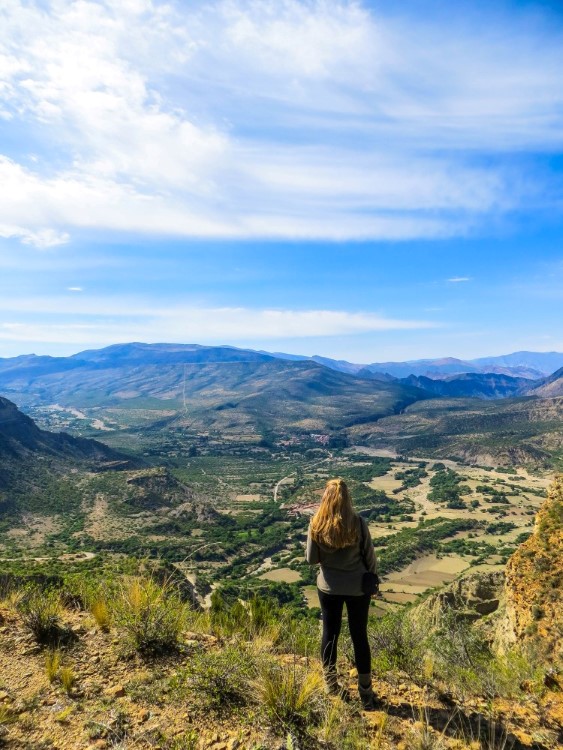
South America, where to go first?
When I first landed in the continent, I knew absolutely nothing about traveling here and realised I should have planned where to travel in South America, so I drew a map of the continent and started plotting potential routes.
I’ve laid out the best South America backpacking routes for you to get the most out of the time you have.
Whether you have two weeks or a month in South America, a shoestring budget or a lush lifestyle, one of these routes will get you started with your trip ideas and help you discover all that South America has to offer.
Before you dive in, it’s also worth checking out our article about what to pack for South America – a guide written after seven years of exploring the continent.
What’s in this article:
What should you consider before planning your South America backpacking route?
- Budget: ‘How much can you spend traveling in South America’ and ‘how much should you spend traveling in South America’ are two very different questions, and both are important. Traveling South America cheaply is possible; the cost of backpacking here is far cheaper than in most other parts of the world and it’s relatively easy to stick to a budget of $50 USD per day. My main tip would be to have a budget so that you don’t overspend but also avoid keeping the purse strings so tight that you miss out on amazing experiences. Identify what is important to you and set aside part of your budget for it before you start.
- Where you will land: This is not only important for the route you pick but also relevant when looking at flight costs and visa restrictions. Hubs such as Lima, Santiago, São Paulo and Bogota generally have the cheapest connections with countries outside of South America, as well as plenty of direct flights between these and other parts of the continent.
- The best time to go to South America: Remember to also think about the seasons; the best time to go to South America really depends on exactly where you’re heading. The northern countries are usually best visited in the dry season (May to September) and the southern countries in summer (October to April). Read our article for more detailed information about the best time to visit South America.
- What do you want to do: Do you want to do a five-day hike in Patagonia, learn to surf in Peru, walk the streets of Buenos Aires or dance salsa in Cartagena? Remember to consider what is important to you to see or do, not only how much time and money you have.
- Is it dangerous to backpack in South America? No, it’s not. Travelling to South America – or any part of the world in fact – requires pre-planning and thought, so you know how to get from A to B safely and without issue. Learning Spanish before you go is helpful but not essential; what you’ll find is that many travellers follow similar South America travel routes, so you’ll quickly find and make plenty of new friends along the way.
- The best itinerary for South America: Ultimately, there is no best itinerary. What matters is that you spend your time and your money seeing destinations and having experiences that will last you a lifetime. All of the South America backpacking routes and places to visit outlined in this post have been tried and tested by myself and other backpackers, so it’s really a choice of deciding which one most appeals to your imagination.
Planning Your Trip to South America?
Save time, stress & money with a customized travel itinerary planned for you by a South America expert
What previous clients have said:
Steph’s itinerary exceeded all expectations. She provided off the beaten path hikes, great restaurants and accommodations, and very helpful local contacts.
Due to the weather we had to deviate from our original plan, however Steph quickly responded to our email during the trip with further recommendations. Her service took all the guess work out of planning our vacation and lead to the most fun and unforgettable trip we have ever had!
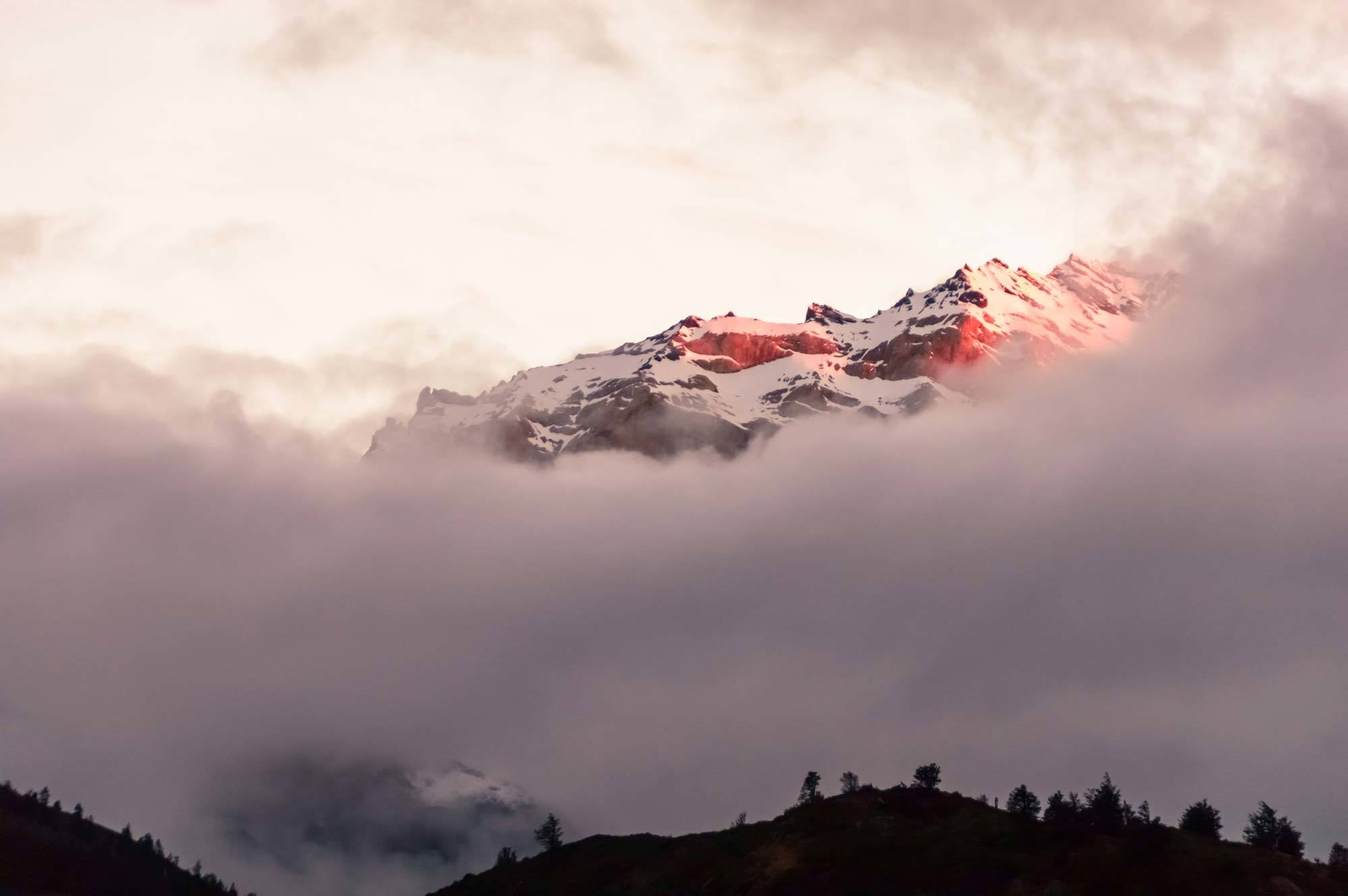
Catherine Bradley
Ten days in South America
Very short trips to South America can be difficult. Cities and tourist attractions are far apart and fast travel (aka flying) is expensive. Good planning will help you make the most of it.
I’ve laid out one itinerary below, but you can also get inspired by the two-week itineraries for Peru and Colombia, as these can easily be adapted to a shorter duration.
Ten Days in Brazil
Brazil is huge, but this ironically, makes it a great destination for a short South American trip – let’s face it: you would never be able to see it all anyway!
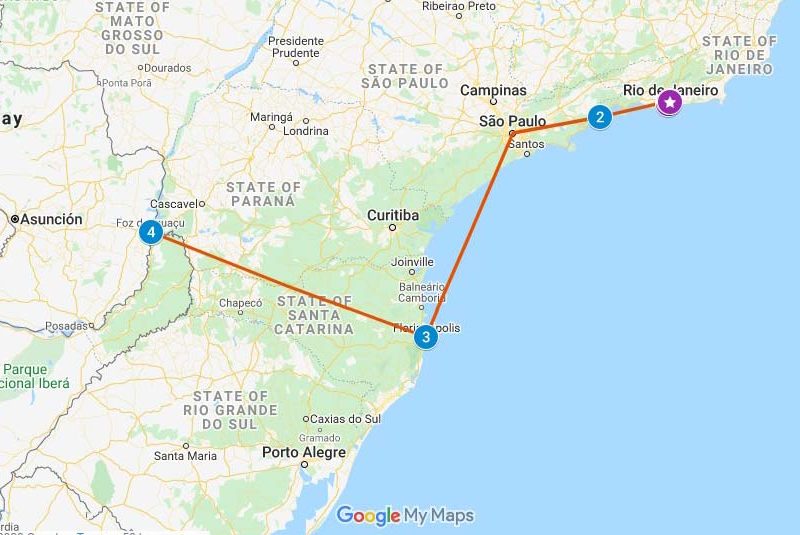
Click the image for an interactive Google Map for this itinerary
This ten-day Brazil itinerary will give you a taste of the fun, flare and beauty of this vast and extraordinary country.
Days One to Three: Start your trip in Rio de Janeiro, a city that is an absolute must-see on any Brazil trip. There is so much to do here that you will need to plan your activities in advance.
Definitely set aside some time to sun yourself on the beaches of Copacabana, Ipanema or Leblon. Hike or train up to the Christ the Redeemer statue for panoramic views of the hilly city and the glittering Atlantic Ocean below.
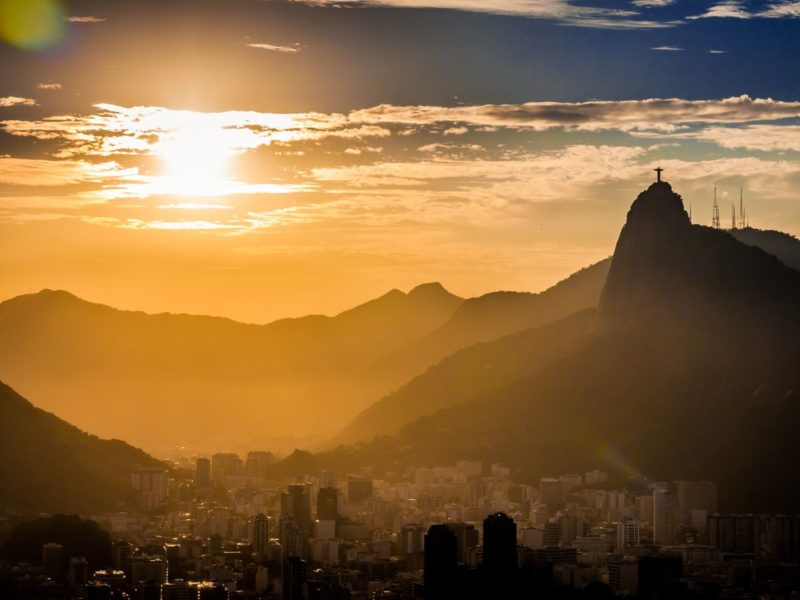
Sunset over Rio de Janeiro.
Inside the city itself, Santa Theresa is a great artistic neighbourhood to explore and Lapa is the area to experience the nightlife of Rio.
Days Four to Six: Next, take a four-hour bus to Paraty, a colonial coastal city with a laid-back atmosphere and plenty of islands only a day trip away. The old city is a UNESCO World Heritage site and is also popular amongst Brazilian holidaymakers.
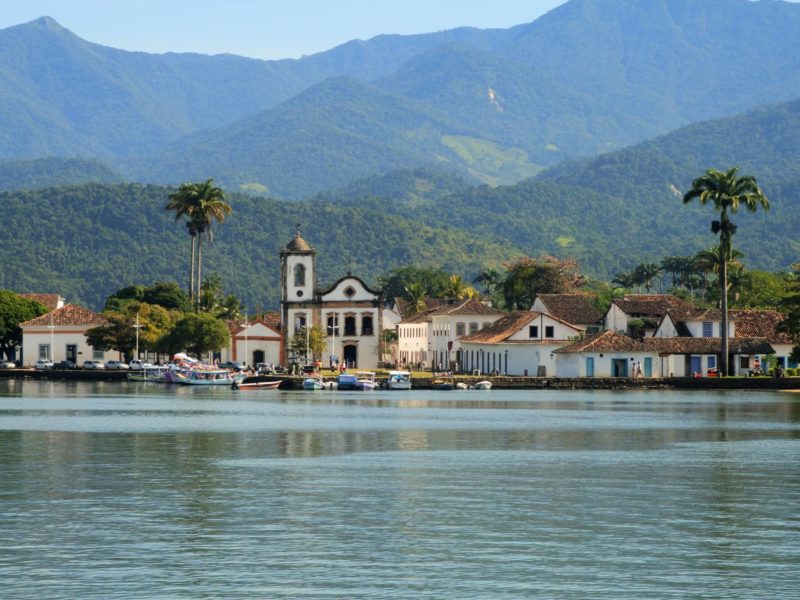
The colonial coastline of Paraty.
You’ll have no problem keeping yourself busy thanks to the rage of gorgeous streets, nearby waterfalls, fine restaurants and interesting boat trips.
Days Seven and Eight: Head south to Florianopolis for some relaxation. You can either take an overnight bus from Paraty or take the bus to Sao Paulo and fly from there. Once you arrive, don’t stay in Florianopolis City; instead, head straight to the island to enjoy its clean and stunning beaches.
You can easily use public transport or rent a car to explore them and the equally striking corners of this gorgeous island.
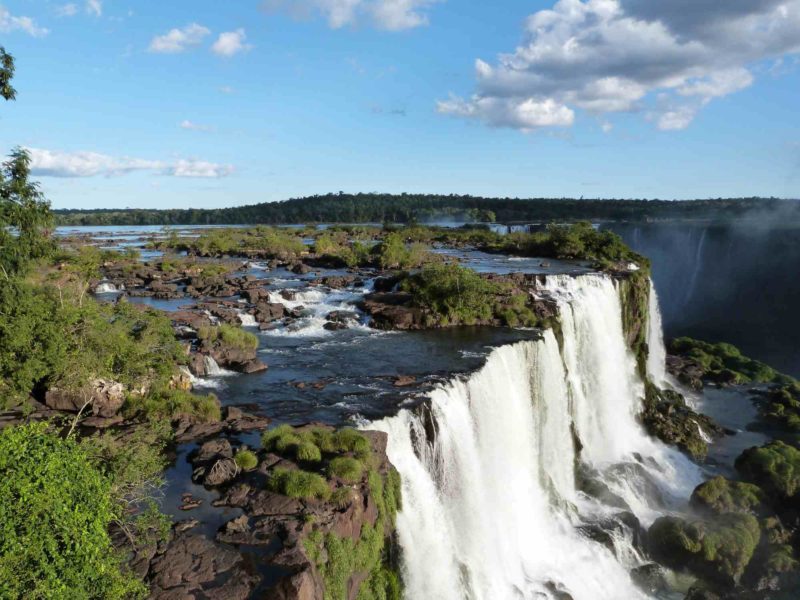
The impressive Iguazu Falls
Days Nine and Ten: Your last stop is Foz do Iguacu (Iguazú Falls), an overnight bus journey from Florianopolis. Another must-see, these falls are a wonder of the natural world and are jaw-droppingly powerful.
On the border with Argentina, they can be viewed from both sides but the Brazilian side is famous for panoramic views of the entire waterfall complex, with various pathways allowing you to catch sight of all 275 falls.
The bottom line: Brazil is too vast to see on any trip that doesn’t span months, but this itinerary gives you a good snapshot of what this beautiful country has to offer.
Two weeks in South America Itinerary
While two weeks is not a lot of time for traveling in a continent as huge as South America, with some forward-thinking, you can still see a lot.
Top tip: Pick one country to explore rather than spread your time too thin. Peru and Colombia are both great places to explore in short periods of time because both are jam-packed with compelling attractions, all of which aren’t very far away from each other.
Two-week Peru Itinerary
Peru is one of the most intriguing countries to travel to in South America – it’s no surprise that it makes most travellers’ bucket lists. Between beautiful cities, fantastic food, awe-inspiring Inca ruins, and rich indigenous culture, you are bound to fall in love.
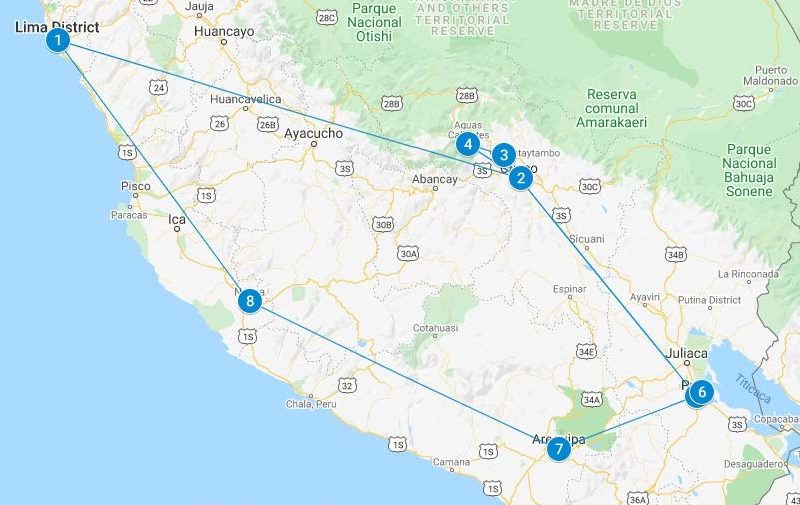
Click the image for an interactive Google Map for this itinerary
For a short trip to South America, this is definitely one of the most rewarding destinations as there are so many things to do here in Peru – in what is actually a relatively small country.
What’s more, Peru has a little for everyone: everything from culture, fine dining, ancient history and jaw-dropping scenery.
Top tip: It’s best to plan your trip in the dry season, which is May through September. This time of year is peak season in Peru but guarantees sunny days that won’t interfere with your plans.
Days One and Two: Start in Lima, the vibrant capital of Peru. Spend some time exploring the boardwalk in fancy Miraflores, the old colonial buildings in the old city centre, and the street art scene of Barranco. If you’re not on a budget, Lima is home to three of the world’s best restaurants: Central, Maido and Astrid y Gastón.
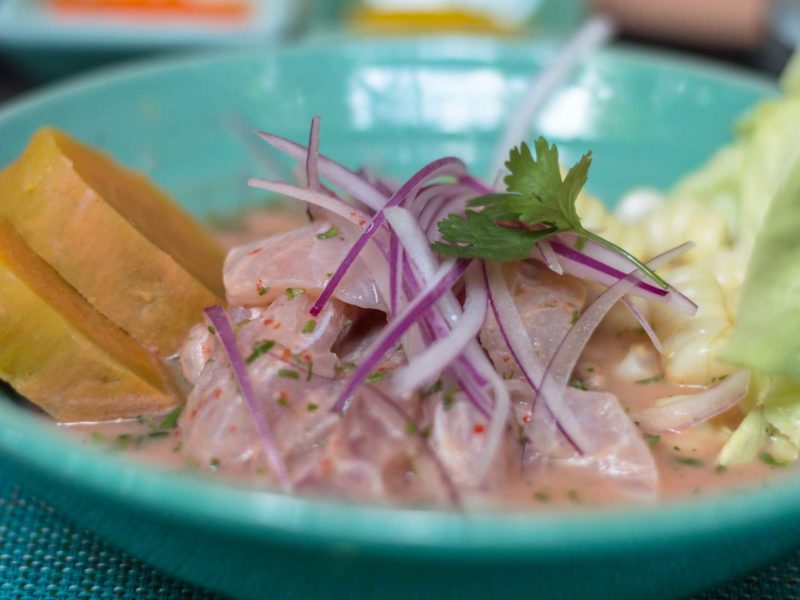
Every region has its own variation on ceviche.
If you’re counting the pennies, try ceviche (a local dish of raw fish, lime and chilli) in Barranco and chifa (Peruvian Chinese food) anywhere.
Days Three to Five: From there, fly to Cusco, the oldest continuously inhabited city in the world. It can get pretty crowded with tourists but is definitely worth it.
Spend a day or two in a city whose history is everywhere you look thanks to the Inca (who built it) and the Spanish (who colonized it). Free walking tours are great for budgets, while souvenir shopping is not so much.
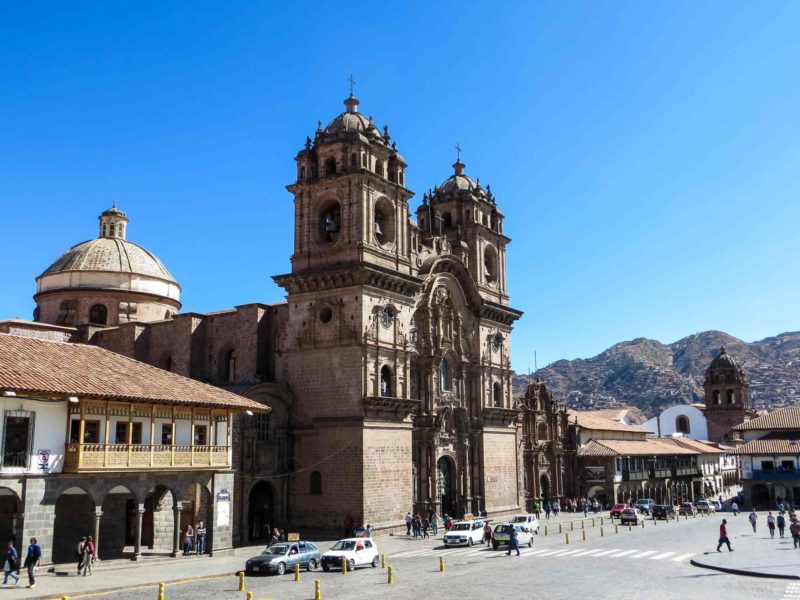
The Plaza de las Armas in Cuzco, Peru.
Days Six to Eight: Once you’ve acclimatized to the altitude, take a tour of the Sacred Valley, and, of course, visit Machu Picchu. The most efficient way to see the ancient Incan citadel is to take the train: it might be expensive, but it’s the fastest option for a short trip. You can stay overnight the Sacred Valley at one of its many hotels and guesthouses, too.
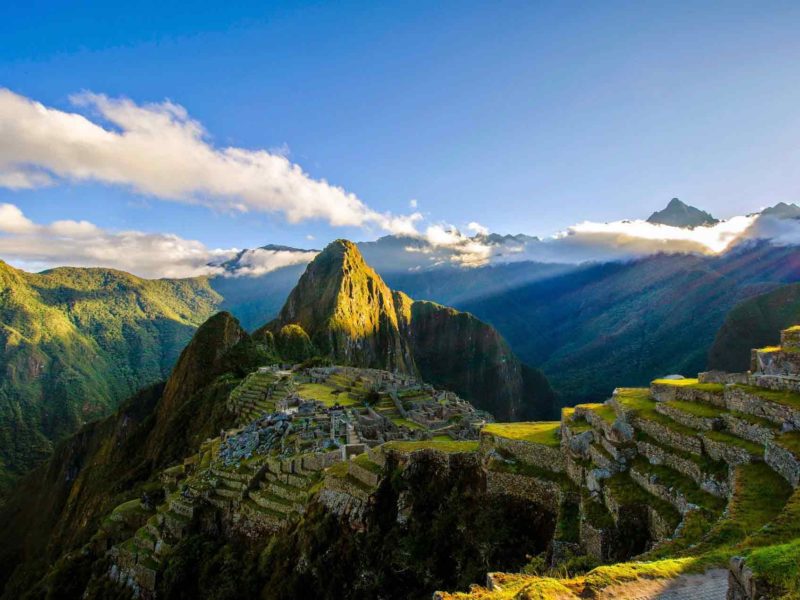
Sunrise over Machu Picchu.
Alternatively, sign up for a two-day bus tour with an agency in Cusco or add an extra day to your itinerary and take an Inca trail hiking tour instead.
Days Nine and Ten: Take a spectacular train ride from Cusco to Puno on the shores of Lake Titicaca. Spend a day visiting the Uros floating reed islands or kayaking on what is the highest freshwater lake in the world.
Days Eleven and Twelve: Catch a bus to Arequipa, a beautiful city nestled below El Misti Volcano. Arequipa’s dazzling white and historical centre is another of Peru’s UNESCO World Heritage sites.
Days Twelve and Thirteen: Bus north up the Pacific coast to Nazca, where you can fly over the famous Nazca Lines and get back to Lima by bus in the afternoon. If you’re on a tight budget, it might be better to spend a few more days in Cusco and the surrounding areas, instead.
Day Fourteen: Get ready for the journey home and have one last plate of ceviche and a pisco sour to bid farewell to your trip South America backpacking trip.
Adapting this itinerary: If you want to make this a shorter trip, cut out Puno and Nazca, and instead head from Cusco to Arequipa and then fly back to Lima.
Two weeks in Colombia
Colombia is one of the best backpacking spots around. It’s cheap, beautiful and the Colombians are largely extremely welcoming and friendly.
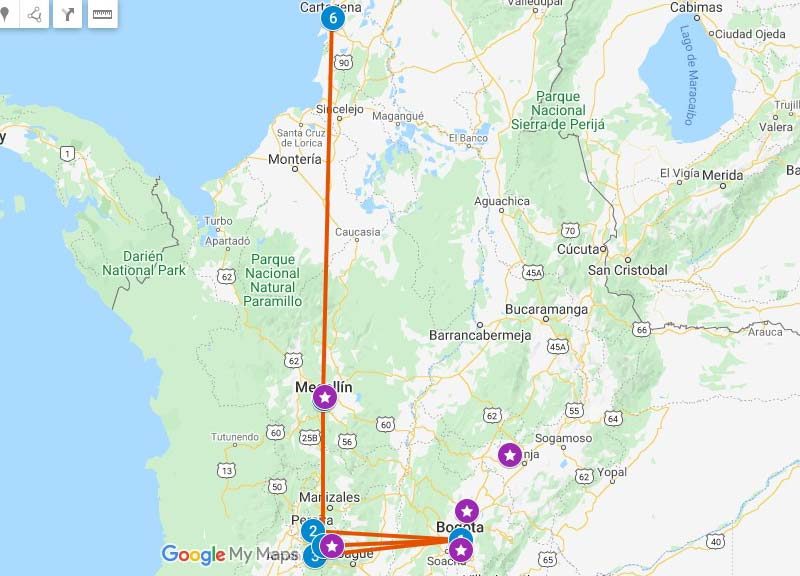
Click the image for an interactive Google Map for this itinerary
It’s up to you whether you prioritise nightlife, beaches or history but, whatever you choose, Colombia is a fantastic destination.
Day 1-4: Start in Bogotá. Colombia’s capital is a diverse, vibrant city filled with bright colours and a dark history. Explore the street art, old buildings, and great coffee, while the world-class Museo del Oro (Gold Museum) can’t be missed.
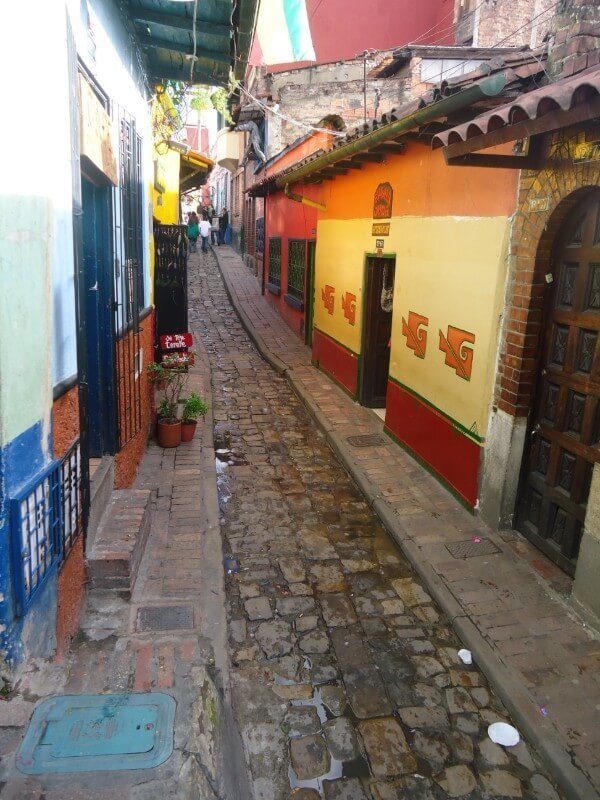
The colorful streets of Bogotá.
If you like to party, Bogotá boasts some of the best nightclubs in South America and day trips should hinge around Villa de Leyva, a beautiful colonial village, as well as the Salt Cathedral in Zipaquirá.
Alternatively, book yourself onto an incredible tour flying out of Bogotá to San Vicente Del Caguán visiting a part of southern Colombia that was, until recently, inaccessible for travel because of the armed conflict.
Truly adventurous travellers can join the three-day Rafting For Peace tour, where you take on the rapids of the Río Pato alongside ex-FARC militants who’ve found rafting a credible means of bringing peace to the region.
Support sustainable, responsible tourism in Colombia – and learn a tonne about the country’s chequered history along the way- by booking the Rafting for Peace tour with IMPULSE Travel Colombia and get a 5% discount by using the code WORLDLY5 at checkout.
Days Five and Six: Fly to Pereira or Armenia where you can either stay in the colourful town of Salento or in a hacienda in one of the surrounding coffee plantations.
Be sure to do a coffee tour and to play the local game of tejo, a fun traditional game that involves throwing disks at a target, with the bull’s eye being a tiny packet of gunpowder. It’s great fun.
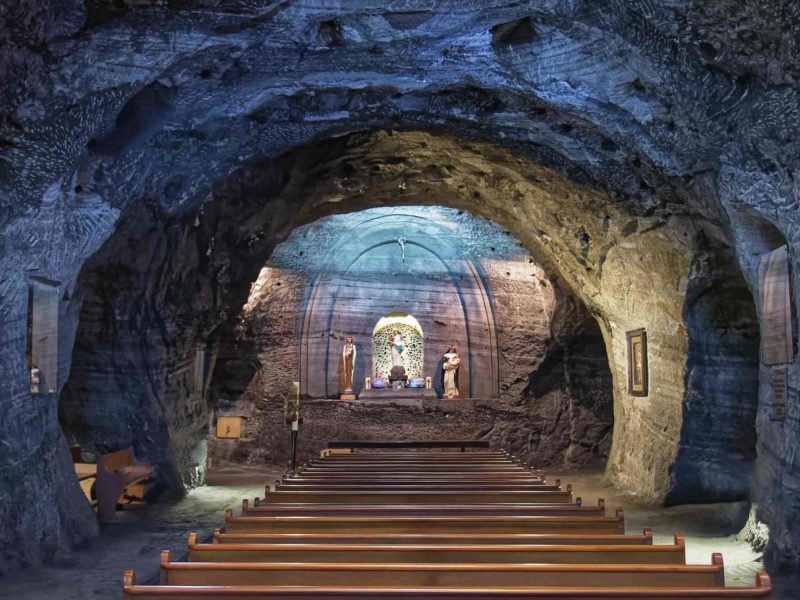
The cathedral in Zipaquira is carved from pure salt.
Spend a day hiking in Valle de Cocora National Park, where you can see wax palms towering up to 60 metres above your head.
Days Seven to Nine: Fly to Medellin, a city famous for its tragic past of gangsters and cocaine. While it was once one of the most dangerous in the world, Medellin is now an innovative modern city, where the weather always feels like spring.
Explore the beautiful parks and some great museums, such as the interactive science museum, Parque Explora.
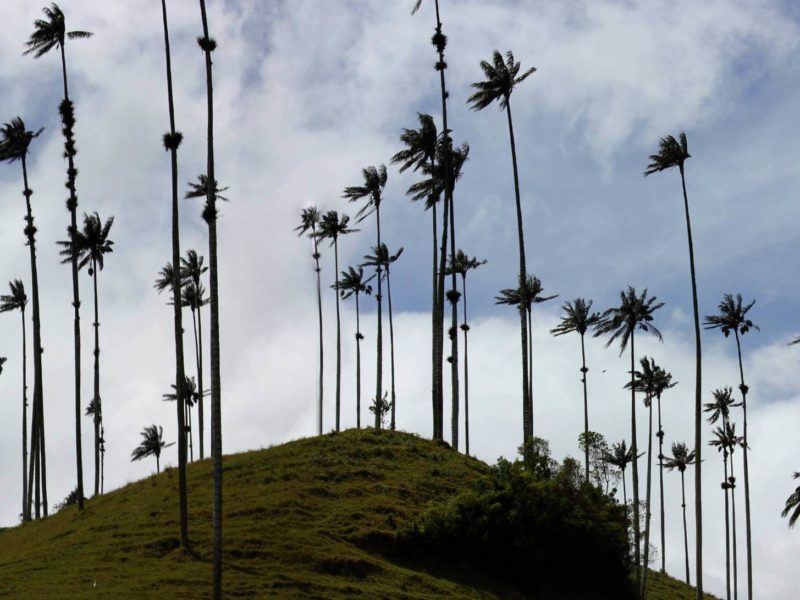
The slender palms of the Valle de Cocora tower far overhead.
Days Ten to Fourteen: Fly up to Cartagena. The Caribbean city of Cartagena de Indias was declared a UNESCO World Heritage site for its incredible colonial old quarter.
You can spend days wandering the picturesque cobbled streets and flowering bougainvillaea. There is a lot of music and food on these busy streets, or you can take a unique tour to learn about the hidden history of Cartagena on a sustainable weaving tour with indigenous Zenú guides.
There are also several beaches and islands nearby that can be visited for a night or just a day trip.
Adapting this itinerary: If you haven’t had enough, or had a different trip in mind, check out what to do on the Caribbean coast in our one-month Colombia itinerary further down or explore this guide to the best places to visit in Colombia.
Two weeks in Chile
Chile is another rewarding destination to spend a two-week vacation in South America. While it’s certainly one of the more expensive destinations on the continent, its diverse landscapes and reliable network of flights and buses make it a perfect place for a short South America trip.
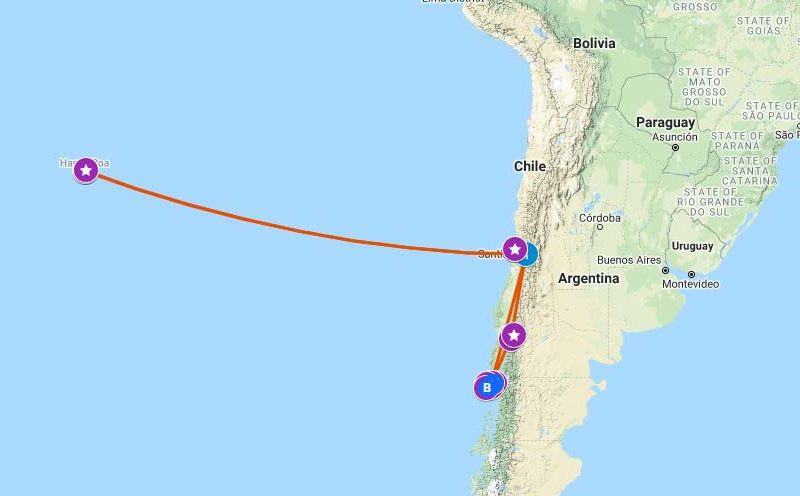
Click the image to for an interactive Google Map for this itinerary
Days One to Three: Fly into Santiago, the Chilean capital city and spend a day exploring its wealth of museums about historic pre-Colombian cultures, sipping on delicious Chilean wine and getting to grips with the city’s thriving gastronomic scene in award-winning Boragó or Restaurant 040.
Take a bus out east to the quirky, street-art daubed streets of Valparaíso, a bohemian university city cascading over a coastal hill. Take a free walking tour or graffiti tour and spend an afternoon appreciating the views from Nobel Prize-winning poet Pablo Neruda’s former residence.
Days Four to Six: Return to Santiago and take a plane six hours west across the Pacific Ocean to the fabled volcanic island, Easter Island.
Here, you can hire a car or take tours out to see the stoic moai statues that line the shore, each representing the ancestors of the local Rapanui people, as well as see the quarry from which each and every last one was carved.
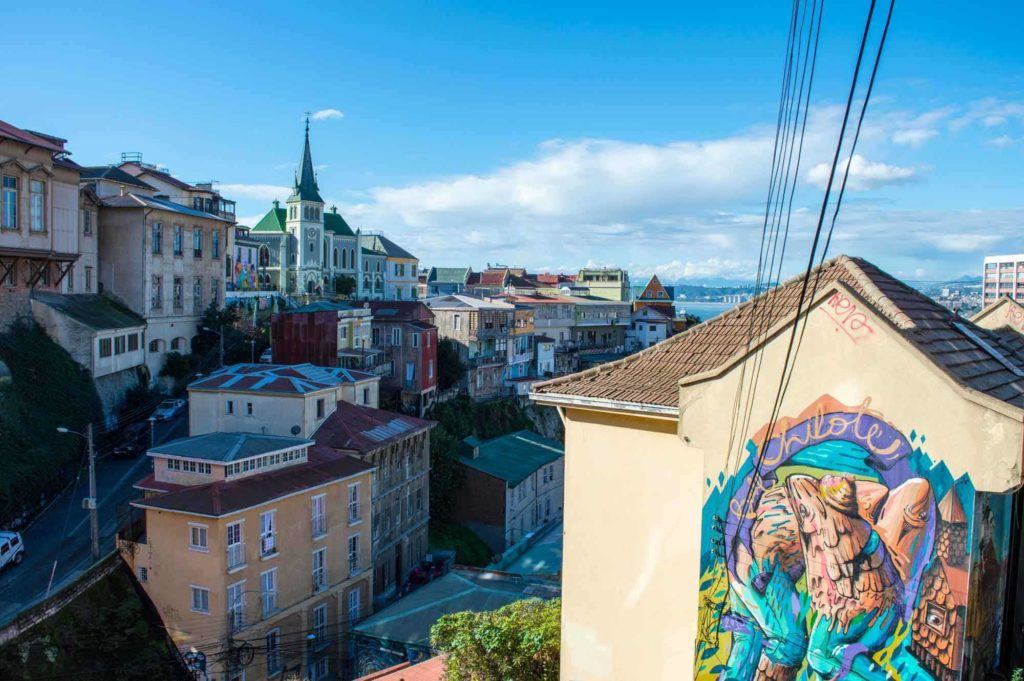
Finding street art in Valparaiso is like the best kind of scavenger hunt.
Catch a performance of Polynesian traditional dance in the main town, Hanga Roa, hike around the north-western coastline to see ruins that receive few – if any – visitors or kick back on the white sands of Anakena, a tropical beach in the island’s far north.
Days Seven to Nine: Fly back to Santiago and take an overnight bus to Pucón, southern Chile’s adventure capital. Trek up the rock-strewn and snow-dusted slopes of Volcán Villarrica before easing yourself into the hot thermal springs that dot the surrounding area.
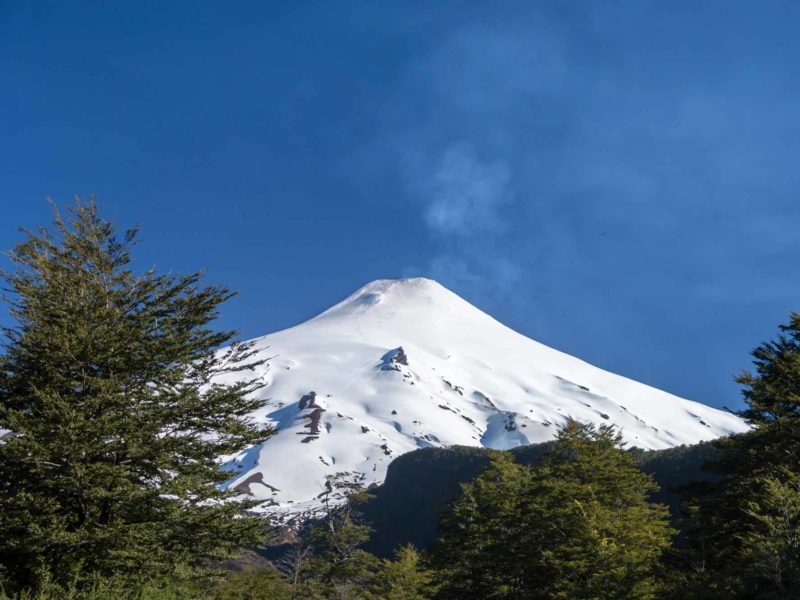
Volcan Villarrica boasts both snowy hiking and thermal hot springs.
Spend a day in nearby Parque Nacional Huerquehue for glorious views of lakes and gushing waterfalls.
Days Ten to Fourteen: Hop on an overnight bus and wake up the next morning in the bustling capital of the Chiloé archipelago, Castro. Catch the city’s houses on stilts – palafitos – in the early morning light for striking photographs.
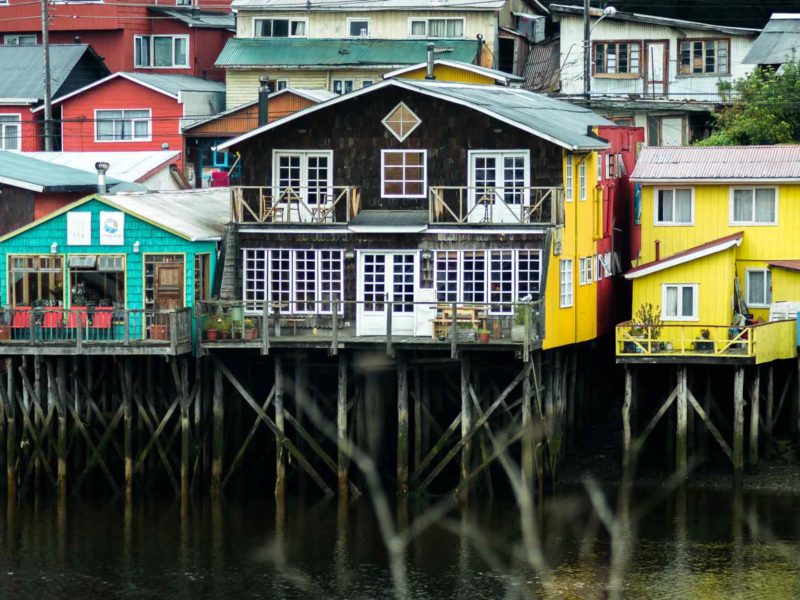
Brightly painted palafitos on the shores of Castro.
Afterwards, take rattling, old public buses between the brightly painted churches of Tenaún, Chonchi and Dalcahue and join the locals for a steaming bowl of curanto (seafood stew) in the latter’s market.
Take the bus out to Parque Nacional Chiloé to hike in lush temperate rainforest and admire the island’s most startlingly empty beaches and follow the path to the Muelle de las Almas for a photograph at a cliffside side pier where you can hear the howls of the dead echo through the air.
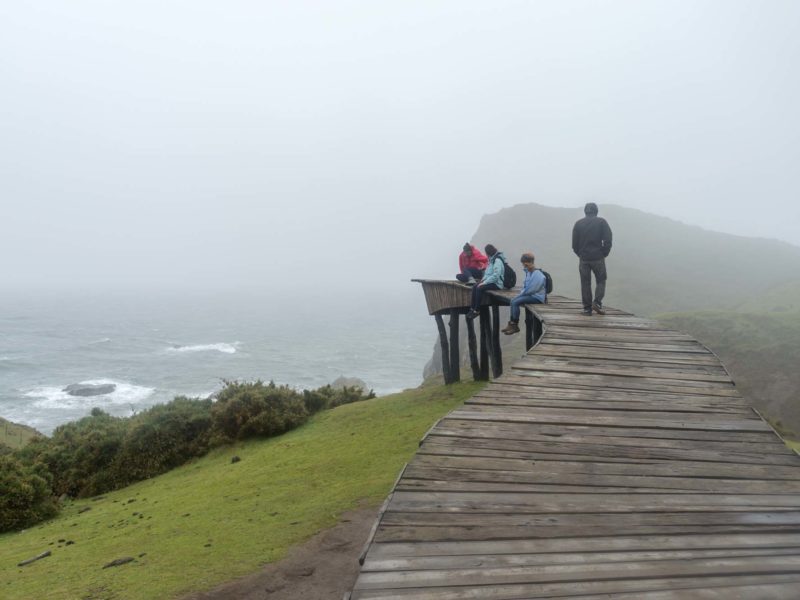
The Muelle de las Almas can feel like the edge of the earth.
Return to Castro and fly back to Santiago.
How to adapt this itinerary: We’ve written more about Chile and how to explore this country – with plenty of alternative suggestions – in this two-week Chile itinerary and you can find itineraries to suit your budget and travel style in my brand new guidebook, Moon Chile.
Want a custom-made Chile itinerary, but without the effort of organising it? Get it planned by an expert (me!) with my travel itinerary planning service (prices starting from $100 USD) or local operator EcoChile Travel who design and book tours throughout the Chile and who offer Worldly Adventurer readers a 5% discount on their services! Find out more information here and book here to claim your discount.
One-month South America Backpacking Routes
My recommendation for a one-month South America itinerary is to not try and fit too much in. You don’t want to burn yourself out by trying to cram everything in, but also you need a little wiggle room for the inevitable late bus or great location that throws off your schedule.
Leave yourself a few days unplanned to use when you need a day off or you just can’t resist spending one more day somewhere.
One-month South America travel itinerary: Peru, Northern Chile and Bolivia
This is a perfect trip for seeing some of the greatest highlights of South America. This backpacking route will take you through the most beautiful and historic sites on the continent.
However, be aware that if you’re looking for a super low-budget trip, this isn’t it. Between the tickets to Machu Picchu and the many tours you will want to do in Bolivia and Chile, this is for someone who’s seeking an action-packed trip and is happy to pay for more expensive tours and transport options.
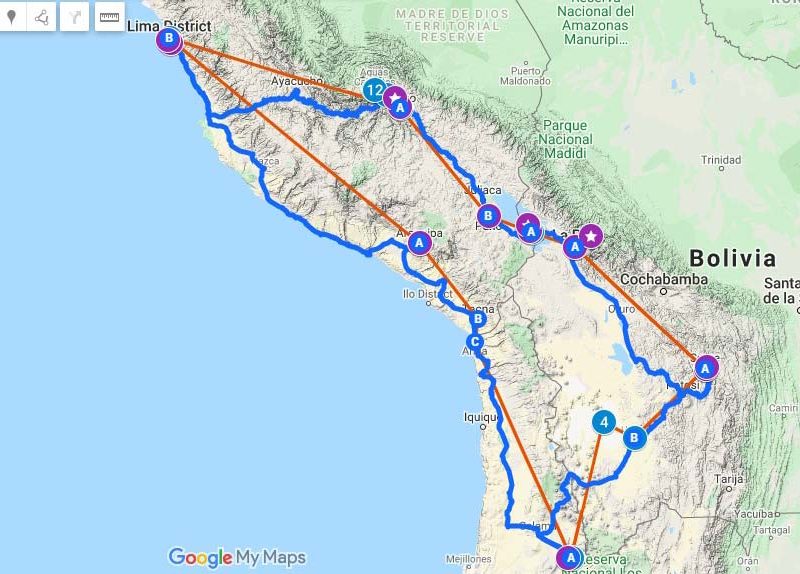
Click the image for an interactive Google Map for this itinerary
Week One
Start your trip flying into Lima, the capital of Peru. It’s both busy and huge, and possibly a little intimidating, but it’s a good introduction to traveling in South America!
Walk the beachfront of Miraflores at sunset, explore the trendy Barranco neighbourhood, and be sure to eat some ceviche, local dish of raw fish, lime and chilli.
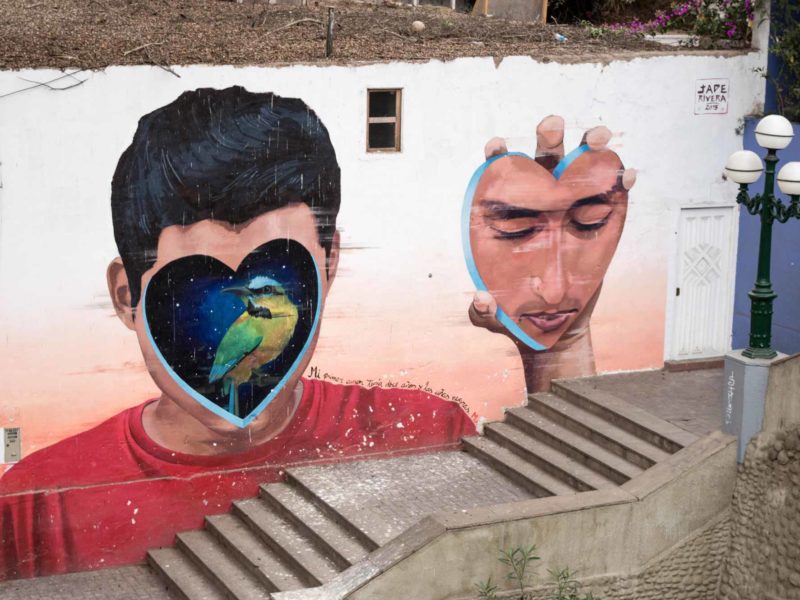
Street art in the Barranco neighborhood of Lima.
It is also worth visiting the Larco Museum to get a better understanding of Peruvian history, the beautiful 18th-century villa houses a large collection showing 5 000 years of pre-Columbian art.
From there, fly or bus it overnight to Arequipa. This beautiful colonial-style city is a UNESCO World Heritage site that sits beneath a volcano. Be sure to do a city walking tour (free, except you will have to tip your guide) to see its detailed, baroque architecture carved from white volcanic stone. Explore what the city has to offer with our comprehensive guide to what to do in Arequipa and find a comfortable place to stay with our guide to accommodation in the city.
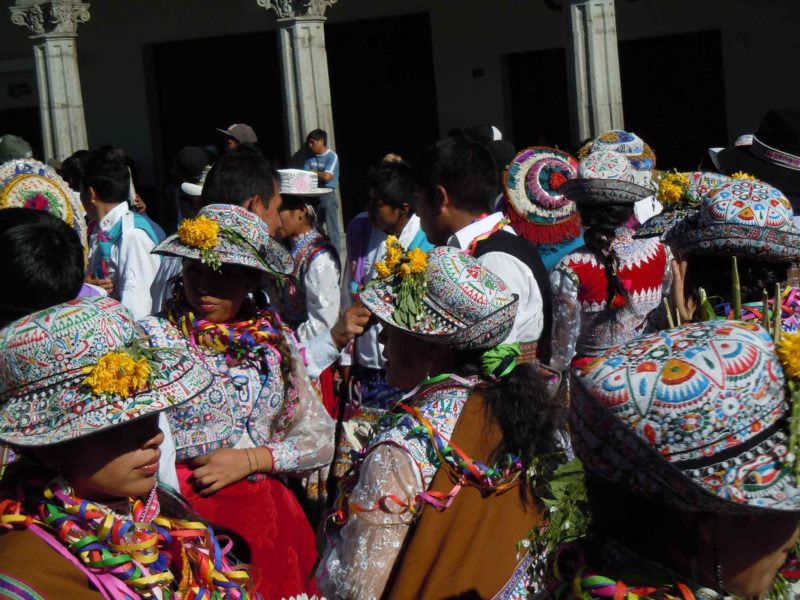
Traditional hats in Arequipa, Peru.
From here you can also take a two- or three-day trip to hike Colca Canyon, the second deepest canyon in the world.
Week Two
Your next stop is San Pedro de Atacama, Chile. Take the morning bus from Arequipa to Tacna, cross over the border to Arica in Chile and then the overnight bus that brings you the next morning to this small desert town on the Chilean-Bolivian border.
While this place is a tourist trap of note, it’s worth visiting because it is the base for a plethora of surrounding activities. My favourites were Valle de la Luna, a truly surreal sand valley of salt and cliffs, and the stargazing tours.
You cannot understand how expansive the universe is until you see a desert night sky with absolutely no light pollution, allowing crystal clear skies with the Milky Way branching above you.
None of the tours are cheap and tour agencies will do their best to overcharge, but you can often negotiate better prices if you are in a group or booking multiple tours with one company, and it’s advisable to ask for more than one place for a quote.
Make friends in your hostel and see who’s found a good deal or is interested in the same tours you are.
San Pedro de Atacama is also the departure point for the three-day trip to the Salar de Uyuni, the picture-perfect salt flats that lie just on the other side of the border in Bolivia.
You can do a one- to four-day tour from Uyuni in Bolivia, but why not use it as a way to travel to Bolivia rather than starting and ending in the same place?
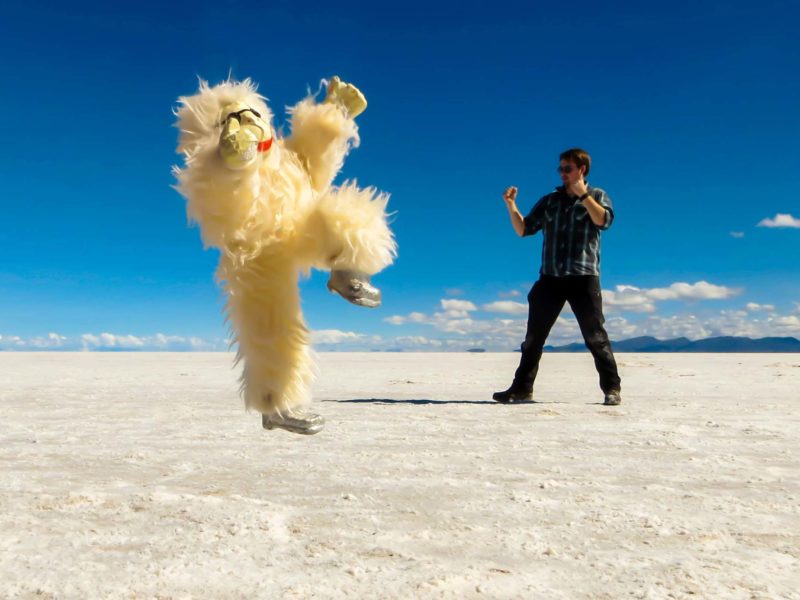
Salar de Uyuni is the perfect place to play with your perspective.
From San Pedro de Atacama, it’s a three-day tour across the border and through the blinding white plateau of the Bolivian salt flats, an experience that is definitely worth it but is far from a luxury travel experience.
The trip is entirely done in a cramped SUV-type vehicle that would have done the trip many times before you arrived and the accommodation is basic. However, the landscapes, lakes and hot springs are some of the most beautiful scenery I have seen anywhere in the world and this experience should not be skipped.
Once you make it to Salar de Uyuni, your tour will give you a day to enjoy the expansive salt flats and then take you to Uyuni before dark. Spend the night in Uyuni, get warm, have a good shower and then a bus to Sucre the next day.
This will be probably one of the worst bus rides of your life – I don’t want to lie to you, as Bolivian buses largely suck. Almost all the buses are old, with no heating, and uncomfortable seats.
Couple these with the narrow, winding rows of the Bolivian Andes, and you get quite a combination. Wear warm clothes and try not to sit at the front.
Week Three
Bolivia’s capital Sucre is a colonial city with great markets and a range of cool things to do. Try and find the hilarious zebras of the zebra crossings: volunteers who dress up as zebras to direct pedestrians across the busier streets.
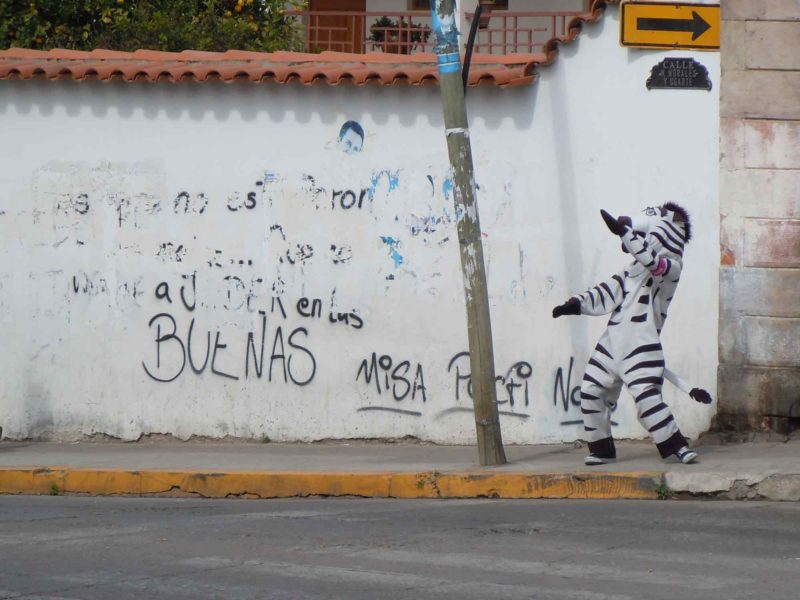
The dancing zebras of Sucre are there to keep you safe.
There is also a two-day hike to the Maragua Crater, where you can see the geological formations that formed around Sucre, including some truly fascinating fossilized dinosaur footprints that were exposed by an earthquake.
If you aren’t interested in the hike but want to see fossils, head over to Park Cretácico, a dinosaur museum just on the outskirts of Sucre that offers tours to the base of an entire wall of hundreds of dinosaur footprints, which was discovered accidentally in still-functioning quarry.
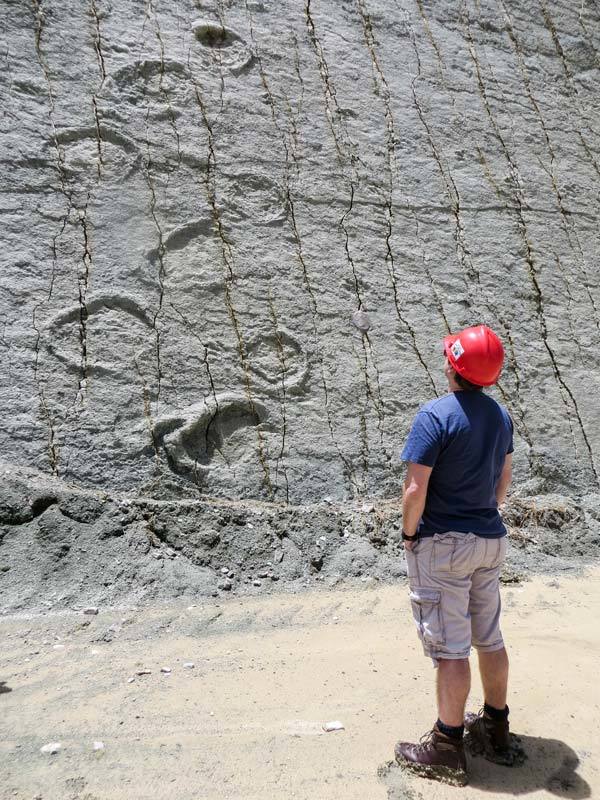
The largest collection of fossilized dinosaur footprints is found in Sucre.
From Sucre, you can either fly or take the bus to La Paz. The capital of Bolivia, La Paz is the highest capital city in the world, sitting at 3,640m above sea level. Don’t underestimate this altitude: it will knock the wind out of you, so take it slow.
Explore the Witches Market, take a whirl at bicycling down the infamous Death Road, or just explore the endless street markets and try my favourite, api morada, a spiced purple corn drink that is drunk warm for breakfast.
Next stop is Lake Titicaca, the highest freshwater lake in the world. Copacabana is a small town on its shores and is famous for being a Catholic pilgrimage site. While the town is a bit of a tourist trap, the glittering blue lake and the expansive sunsets are definitely worth a visit.
Spend a day or two on the Isla del Sol, believed by the Incans to be the birthplace of the sun. This tranquil island has a walking path that crosses the length of it and is dotted with ruins and fishing villages.
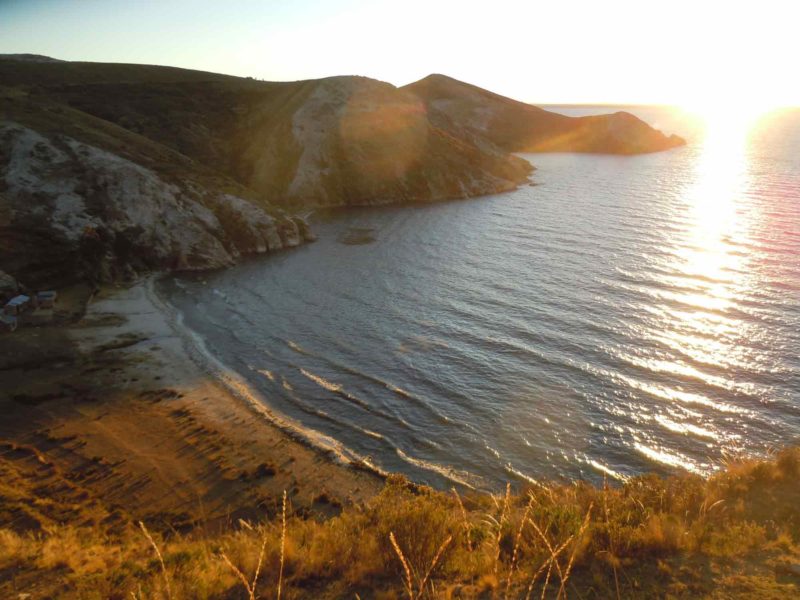
The Isla del Sol was believed to be the birthplace of the sun and is home to several archaeological sites.
It is now time to return to Peru. Take a tourist bus from Copacabana to Cusco. You can stop along the way in Puno on the Peruvian side of Lake Titicaca to see the floating reed villages of the Uros people.
There is also an option to take a cultural bus tour from Puno where you can learn some Peruvian history and see some pre-Incan sites along the way.
There are a few companies offering the service but Inca Express are what we’d recommend.
Week Four
You should be acclimated by the time you make it to Cusco, the oldest continuously inhabited city in the world. Spend a day or two here exploring the cobblestone streets and local Inca sites, like Sacsayhuaman.
Free walking tours are great for budgets, and it is a fantastic place for some souvenir shopping, but watch out for inflated tourist prices.
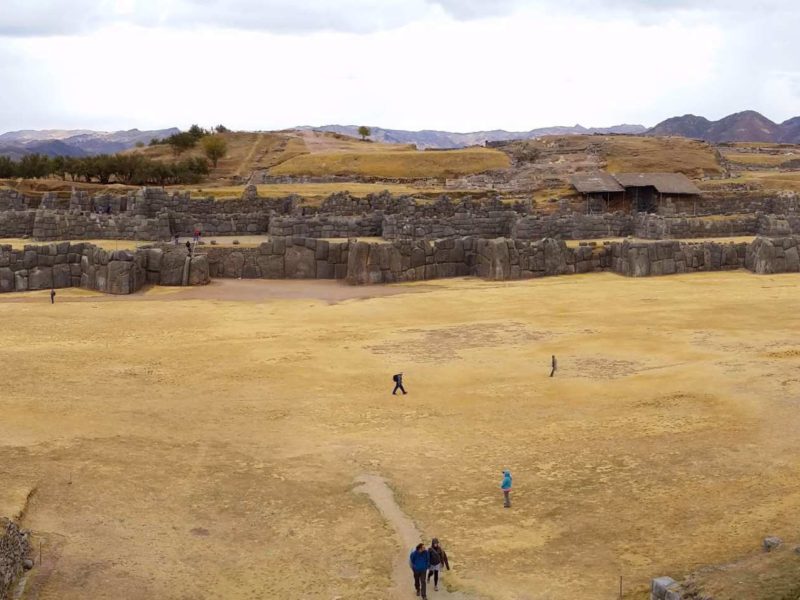
The interlocking stones of Sacsayhuaman have helped the plaza survive devastating earthquakes.
Cusco was once the capital of the Incan Empire and a large centre during Spanish colonial rule. The city has retained archaeological and architectural elements from its complex history, meaning there is so much to explore.
Be careful to leave enough time at the end of your trip to really enjoy it. You could very easily spend a week here and still have things to do every day.
When you have soaked up Cusco, head out on a tour of the Sacred Valley or stay over in Ollantaytambo, home to a massive Incan fortress and a great base for exploring the valley.
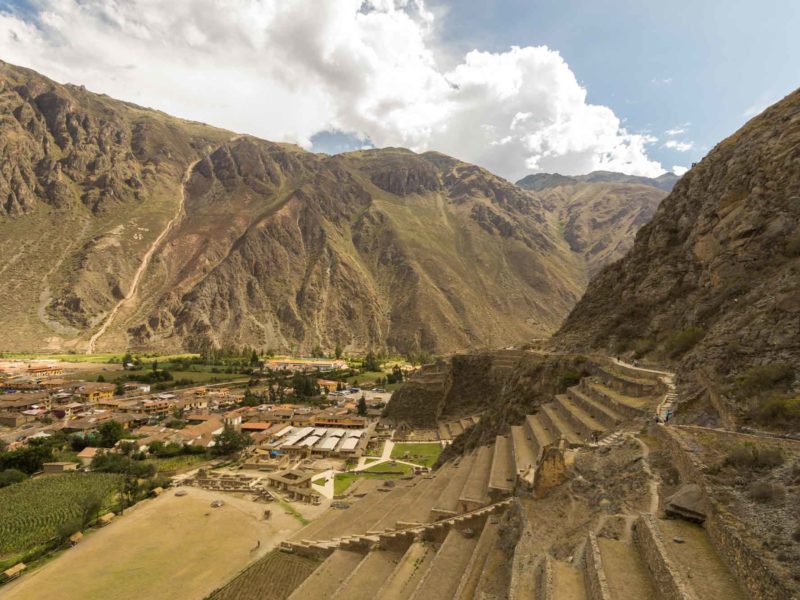
Ollantaytambo is a popular starting point for the Inca Trail trek to Machu Picchu.
This itinerary sees you saving the best for last – the purpose for most people’s trips: Machu Picchu. The most efficient way to get to the ancient Incan citadel is to take the train.
While expensive, this method will save you a lot of time as the alternative involves multiple busses and a long walk; alternatively, consider hiking the four-day, famed Inca highway, the Inca Trail instead.
Have a day exploring the ruins and then either spend the night in the nearby town of Aguas Calientes or head back to Cusco.
The bus back to Lima is a long one, so if you can afford the flight back I would recommend it.
The bottom-line: And then that’s it! It’s a lot to fit into a month but you’ll really have covered some ground and made the most of your trip thanks to this one-month South America backpacking route.
One-month South America travel itinerary: Colombia
If I had one month to travel in South America, I would choose to spend it in Colombia. It is fun, beautiful and rich in history. This trip will show you the sights and leave a lot of room for enjoying the culture of this colourful country.
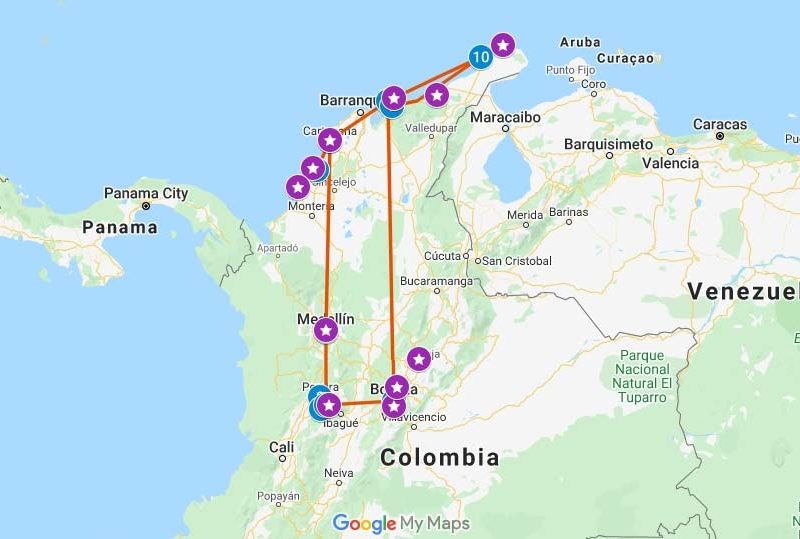
Click the image for an interactive Google Map for this itinerary
Seriously: Colombia should be on every backpacker’s South America wish list!
The two-week Colombia itinerary above can easily be extended to become one month in the country. Once you have completed this two-week route and ended up in Cartagena, spend the extra two weeks on the Caribbean coast.
The northern coast is the beautiful, picture-perfect shoreline of your beach holiday dreams. As you head east along the coast the distances between towns are small and easily crossed by local bus.
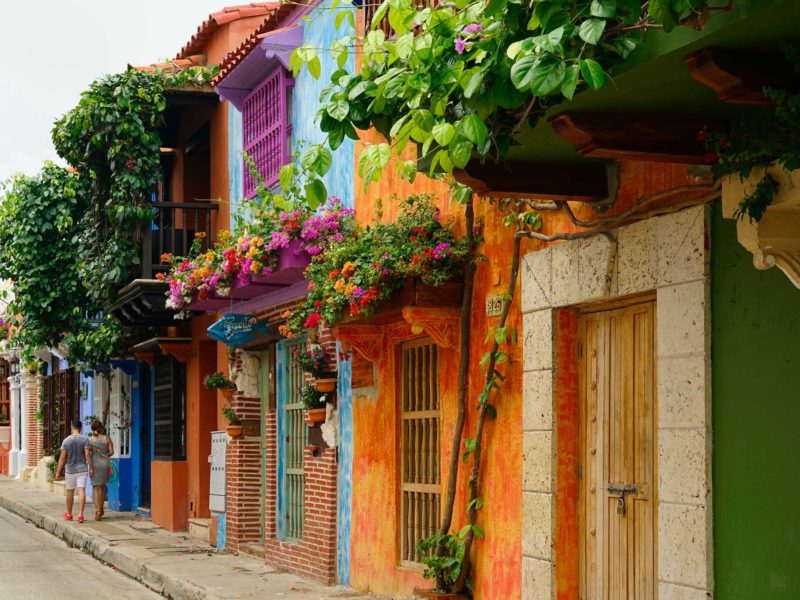
The colorful streets of colonial Cartagena Columbia.
Week Three
Now you’ve explored central Colombia and made it to Cartagena, you have a number of options of where to go next. If some relaxation is what you are after, consider visiting the San Bernardo islands.
Located only an hour’s boat ride from the mainland, this island is also home to the marvellous Casa En El Agua, an eco-hostel built as an island in a national park.
Otherwise there’s Isla Fuerte, once a hiding place for pirates and drug smugglers, which is now filled with a sleepy village, many donkeys and great open-air bars.
If relaxation doesn’t strike the right tone for you, instead, from Cartegena head east up the coast to Santa Marta for some scuba diving and to use it as a base for visiting the surrounding areas.
Just down the road is the world-famous Tayrona National Park, a gorgeous protected area where the Sierra Nevada de Santa Marta mountains meet the coast. Palm-covered coves, thick rainforest, lagoons and white sand beaches support rich biodiversity. You can hike, swim and even stay overnight in this expansive park.
Week Four
If the Caribbean heat is getting to you, take a jeep from Santa Marta to the cooler climate of Minca, a jungle mountain village with some incredible hostels and waterfall hikes.
Your next stop should be Palomino, a beachfront town of cocktails and relaxation. You can tube down the river and swim offshore from long, sandy beaches.
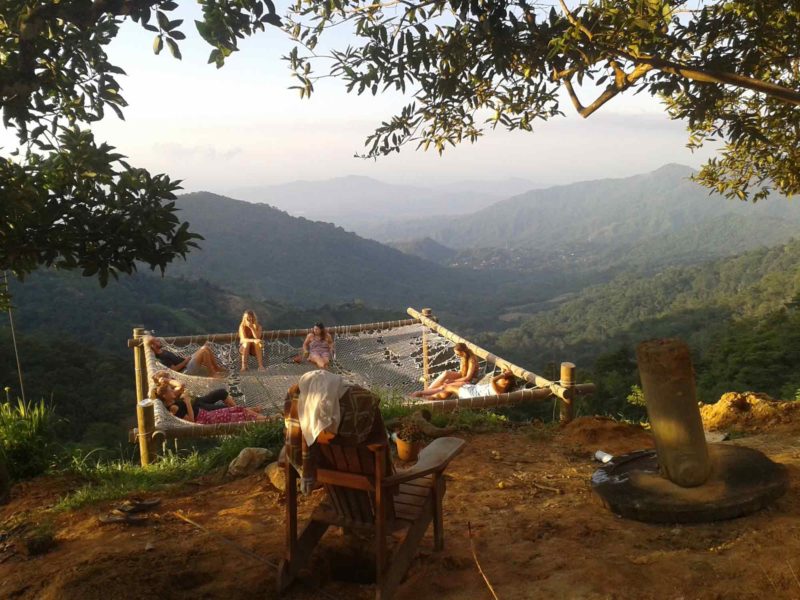
Relax in the cool mountains surrounding Minca Colombia.
Continue on towards the desert in the North Eastern corner of Colombia. A great stop along the way is Los Flamencos Natural Reserve to see flamingos and other bird life. The last destination is Cabo de la Vela, a beach town where it almost never rains – it is in the desert after all.
Learn how to kitesurf and dine on the local langostino, a type of crayfish. Take a day trip up to Punta Gallinas, the northern tip of South America, and see the beautiful dunes of northern coast.
From there, bus back to Santa Marta and fly back to Bogota to catch your flight home.
The bottom-line: This varied backpacking travel itinerary is for someone looking for a rich combination of history, beaches – and plenty of fun!
One month in Patagonia
We’re obsessed with Patagonia on this website, and we’ve got plenty of itinerary ideas to sink your teeth into.
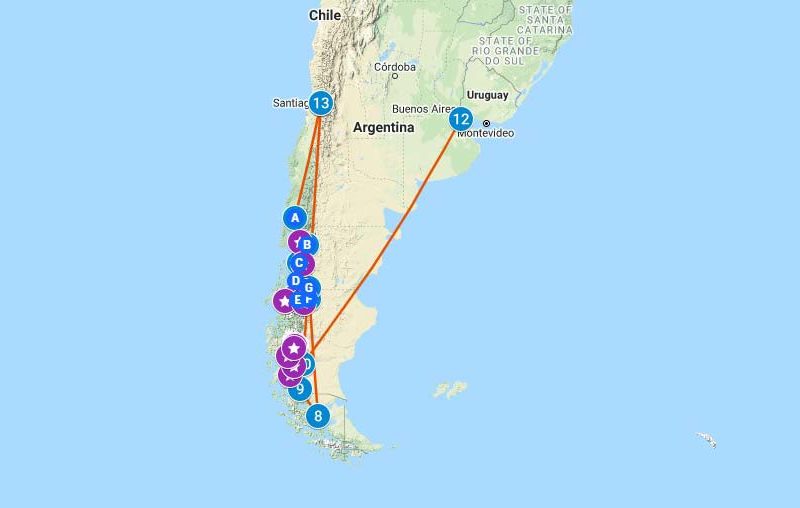
Click the image for an interactive Google Map for this itinerary.
Week One
Fly from Santiago south to Puerto Montt, where you can pick up a hire car (get the low-down on driving in Patagonia before you do).
Drive south down Carretera Austral, South America’s finest road trip and stop to hike and admire the landscapes of lush, temperate rainforest, steaming volcanoes and pristine fjords.
Spend a few days trekking and relaxing in hot springs in Parque Nacional Pumalín before driving southeast to Futaleufú to experience the best white-water rafting in South America.
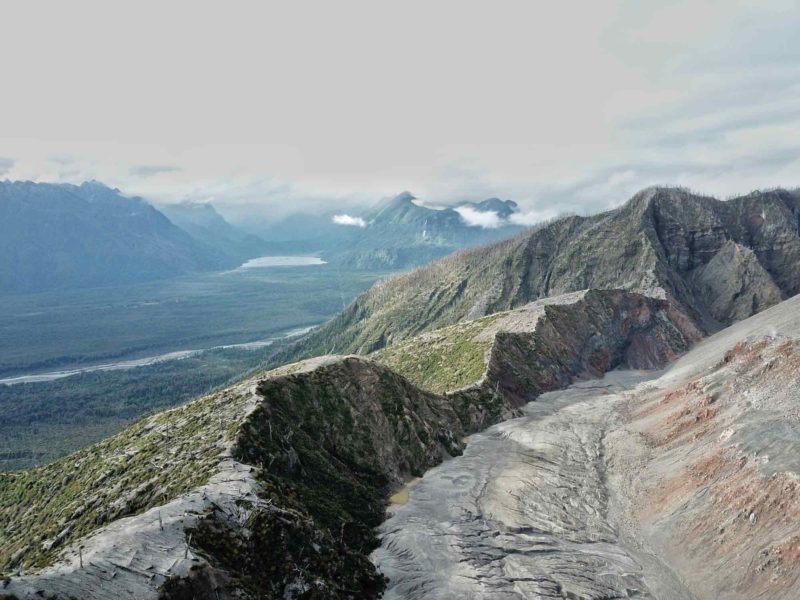
Pumalin is part of the largest national park in South America.
Continue the drive south via Puyuhuapi, to see the truly remarkable Queulat Hanging Glacier, and then on to Parque Nacional Cerro Castillo, for a day or even four-day traverse through one of Patagonia’s newest national parks.
Covid-19 update: You MUST make a reservation in order to visit Parque Nacional Queulat where the Queulat Hanging Glacier is located. You can do this on this website, but you will need to pay in cash (bring small notes) upon arrival. You can only enter the park between 9:00am and 14:30pm (you can stay within the park until 16.30pm) and you must bring your reservation code on your phone or printed off to show at the park entrance.
Covid-19 update: The Cerro Castillo Traverse is now fully open. The Cerro Castillo Traverse is partially closed, due to a lack of CONAF staff. Currently, you can still hike the Sendero Mirador Laguna Cerro Castillo and the path from Acceso Estero Parada to Laguna Duff (see the map here for details). This information was correct as of January 2022.
Week Two
Continue on your way south, cruising along this southern highway to reach Puerto Río Tranquilo where you can take a speedboat or paddle a kayak out to the candy-cane marble caves.
Spend an extra day either ice trekking on the Exploradores Glacier or – if your budget is big enough – taking a day cruise out to the Glaciar San Rafael.
Do a loop of the mesmerizingly blue waters of Lago General Carrera, stopping at Chile Chico to visit the northern sector of Parque Nacional Patagonia, Sector Jeinimeni, for shorts hikes and outstanding scenery, before taking the boat north across the lake and return your car to Balmaceda airport.
Week Three
Fly from Balmaceda to Punta Arenas and take the bus north to Puerto Natales, where you can organize your equipment and food for the four- or five-day W trek (or, if you’ve got more time, the 10-day circuit) in Parque Nacional Torres del Paine.
If you’ve got more time, board the 32-hour TABSA ferry from Punta Arenas to Puerto Williams, the world’s southernmost settlement ($151,110 CLP ($196 USD).
It sails through the Beagle Channel and its most dazzling section: Glacier Alley – a stretch of water lined by hanging tidewater glaciers. Very expensive cruise ships normally ply this route; instead, the Yaghan ferry is the local form of transport (and priced accordingly!).
From Puerto Williams, which is home to plenty of hiking, you can cross the Beagle Channel and spend a day or two in Ushuaia before flying up to El Calafate.
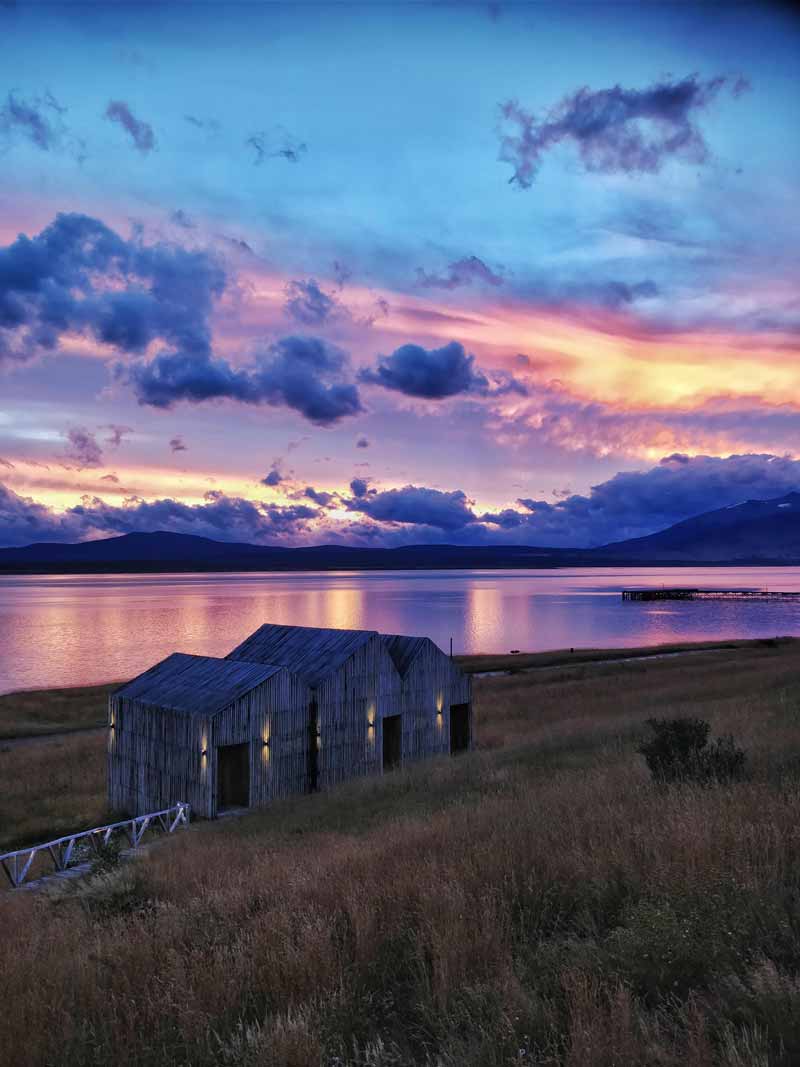
Puerto Natales is the starting point for some of the best hiking in Chile.
Week Four
When you’ve accomplished the challenge of hiking in the remote Patagonia scenery near Puerto Natales, board a bus across the border to El Calafate, a small town in striking distance of the awe-inspiring Glacier Perito Moreno.
Take the public bus for a day tour out to the boardwalks that sit beneath the glacier’s snout.
Back in El Calafate, take a bus north to El Chaltén, Argentine Patagonia’s hiking capital.
Set on the very outskirts of Parque Nacional Los Glaciares, this town makes a great place from which to approach a range of day hikes, including to Laguna de los Tres and Laguna Torre, both of which boast splendid mountain reflections in sparkling glacial lakes.
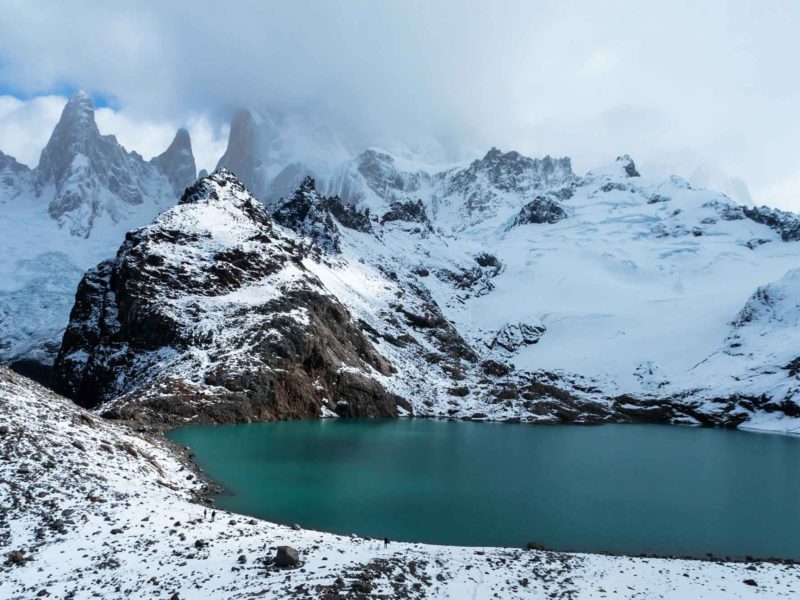
Laguna de los Tres is a rugged but beautiful day hike from El Chalten
If you’ve more time and are an experienced hiker, embark on the four-day Huemul trek, which takes you in a loop of the park with stunning vistas of the Southern Patagonia Ice Field.
Return by bus to El Calafate and fly to Buenos Aires or continue on from here back to Santiago.
How to adapt this itinerary: If you’ve got less time, it is possible to explore Patagonia in just a one- or two-week vacation. For more information, we’ve gone into more depth about visiting both the Chilean and Argentine sides of this region, including the best national parks, road trip destinations and most remote areas in this comprehensive post about Patagonia backpacking itineraries.
Source https://tourthetropics.com/guides/the-10-best-countries-to-visit-in-south-america/
Source https://worldlyadventurer.com/south-america-backpacking-routes/
Source